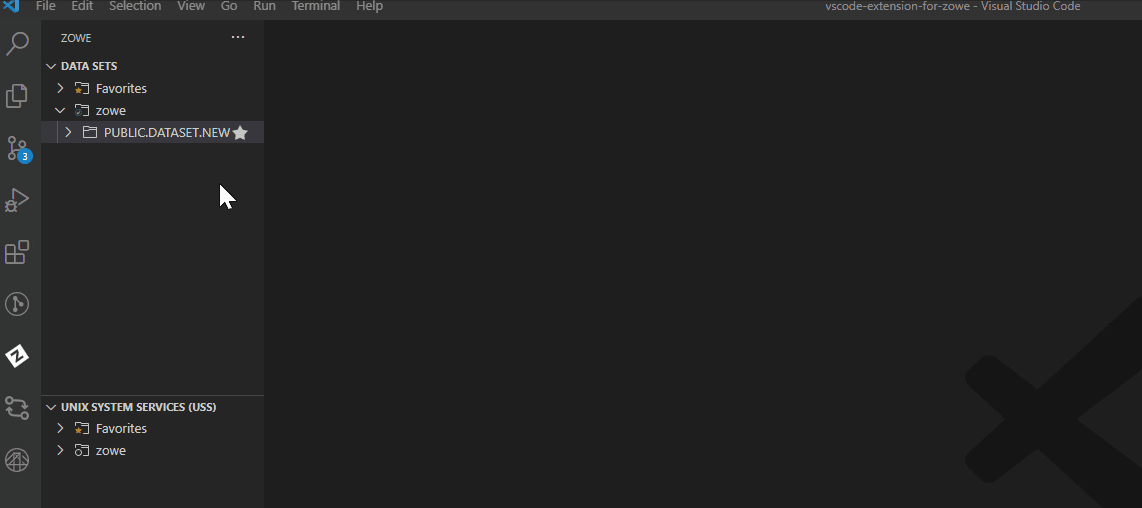Working with data sets
Working with data sets
Viewing and accessing multiple profiles simultaneously
-
Expand the DATA SETS tree in the Side Bar, and click the + icon.
-
Select the profiles from the Quick Pick menu to add them to the Side Bar.
-
Click the Search icon for each profile to search and select associated data sets.
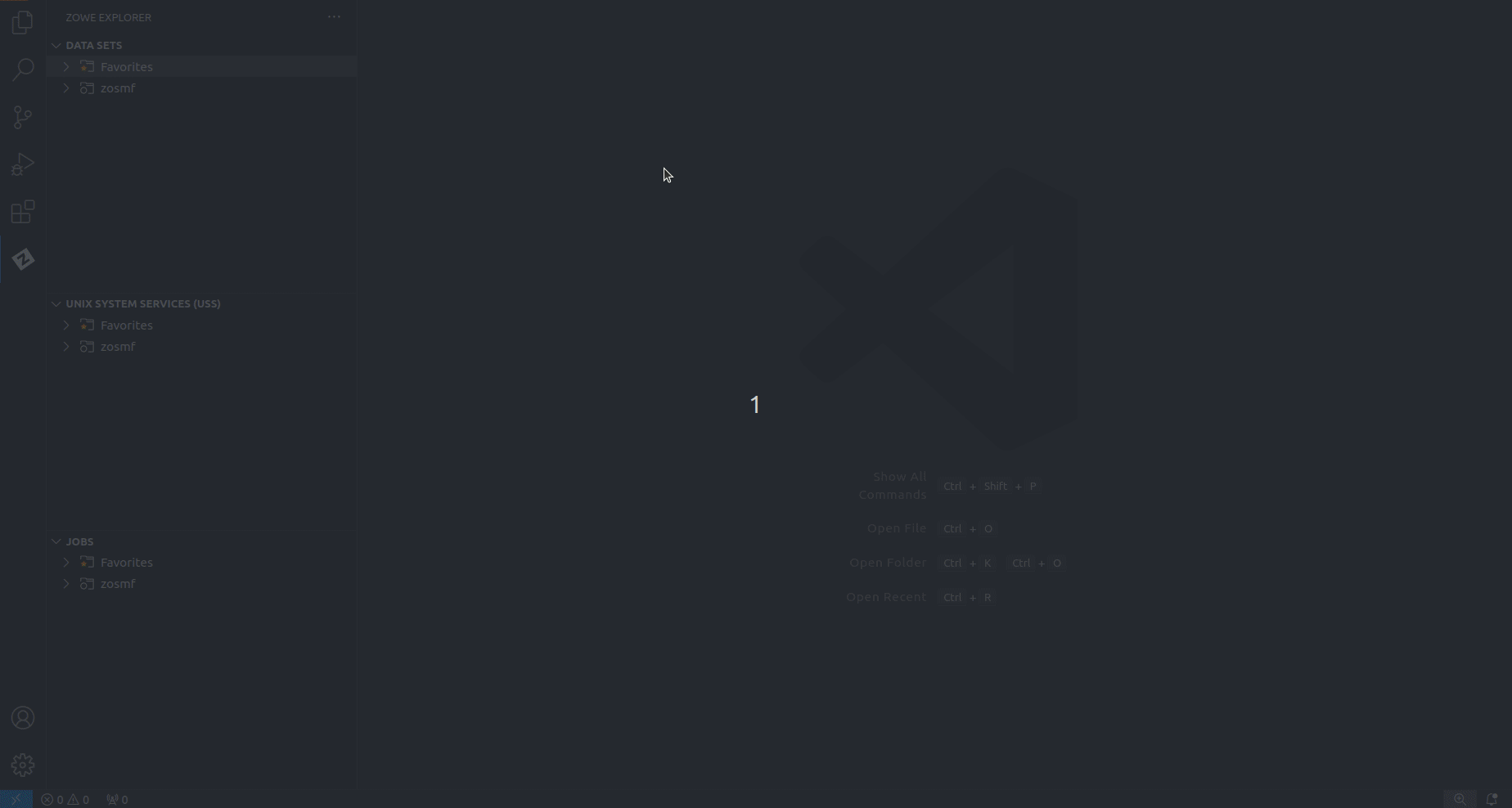
Viewing data sets and using multiple filters
-
Expand the DATA SETS tree in the Side Bar.
-
Click on the Search icon next to a profile to search for a pattern that matches the data set that you want to view.
Search results display under the profile in the Side Bar.
tipTo use multiple filters, separate individual entries with a comma. You can append or postpend any filter with an
*to indicate a wildcard search. You cannot enter an*as the entire pattern.
Viewing data sets with member filters
-
Expand the DATA SETS tree in the Side Bar.
-
Click on the Search icon next to a profile.
-
In the Quick Pick, enter or select a search pattern in the
HLQ.ZZZ.SSS(MEMBERNAME)format to filter search results.The specified member displays under the profile in the Side Bar.
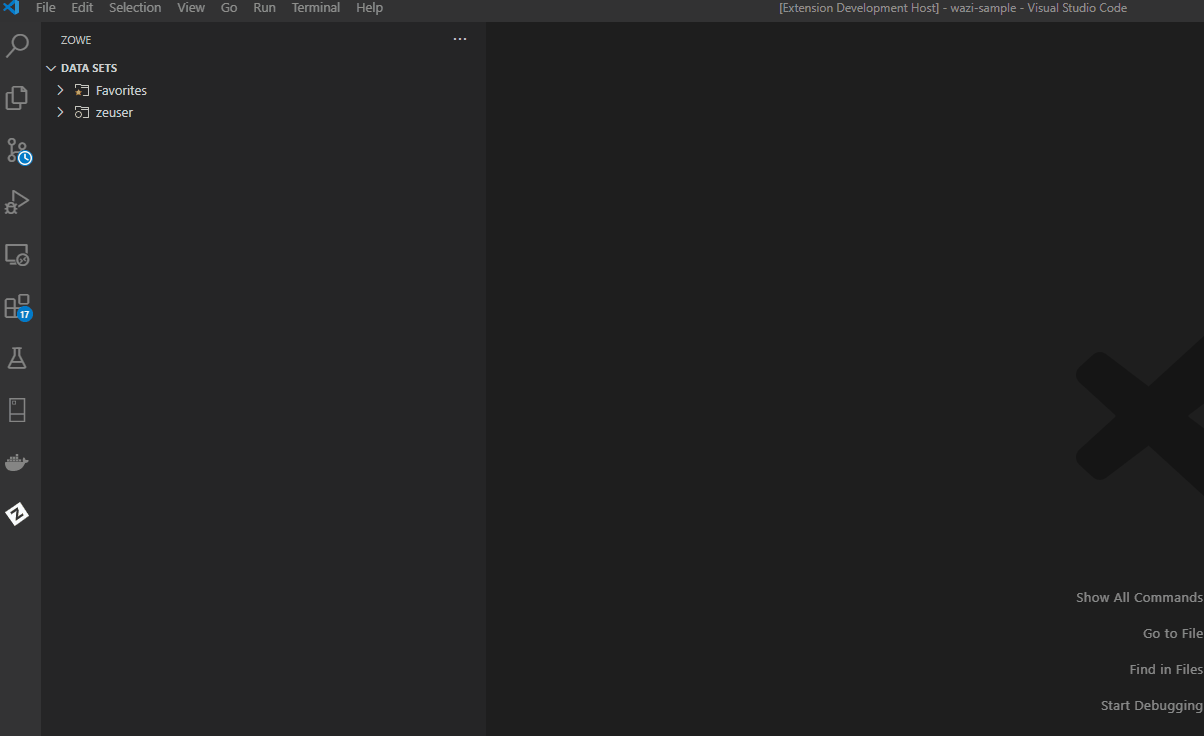
Refreshing the list of data sets
-
Hover over DATA SETS in the Side Bar.
-
Click the Refresh All icon.
The list of data sets is updated to reflect the latest changes.
Renaming data sets
-
Expand the DATA SETS tree in the Side Bar.
-
Click on the Search icon next to a profile to search for a pattern that matches the data set that you want to view.
Search results display under the profile in the Side Bar.
-
Right-click the desired data set and select the Rename Data Set option.
-
Enter the new name of the data set in the input box.
The data set is renamed and displays the new name in the Side Bar.
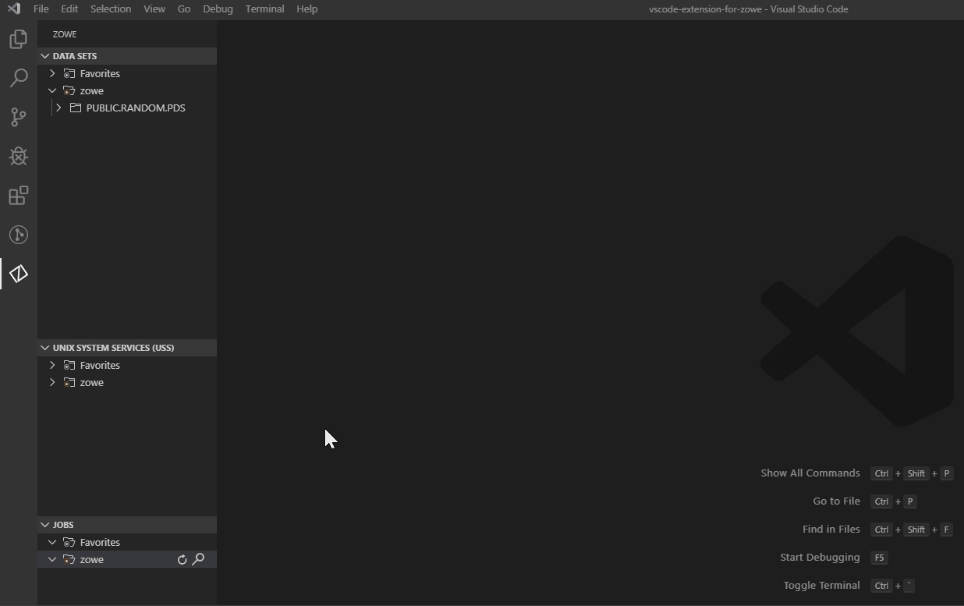
Copying data set members
-
Expand the DATA SETS tree in the Side Bar.
-
Click on the Search icon next to a profile to search for a pattern that matches the data set that you want to view.
Search results display under the profile in the Side Bar.
-
Right-click the desired member and select the Copy option.
-
Right-click the data set where the member is to be contained and select the Paste option.
-
In the Quick Pick, enter the name of the copied member.
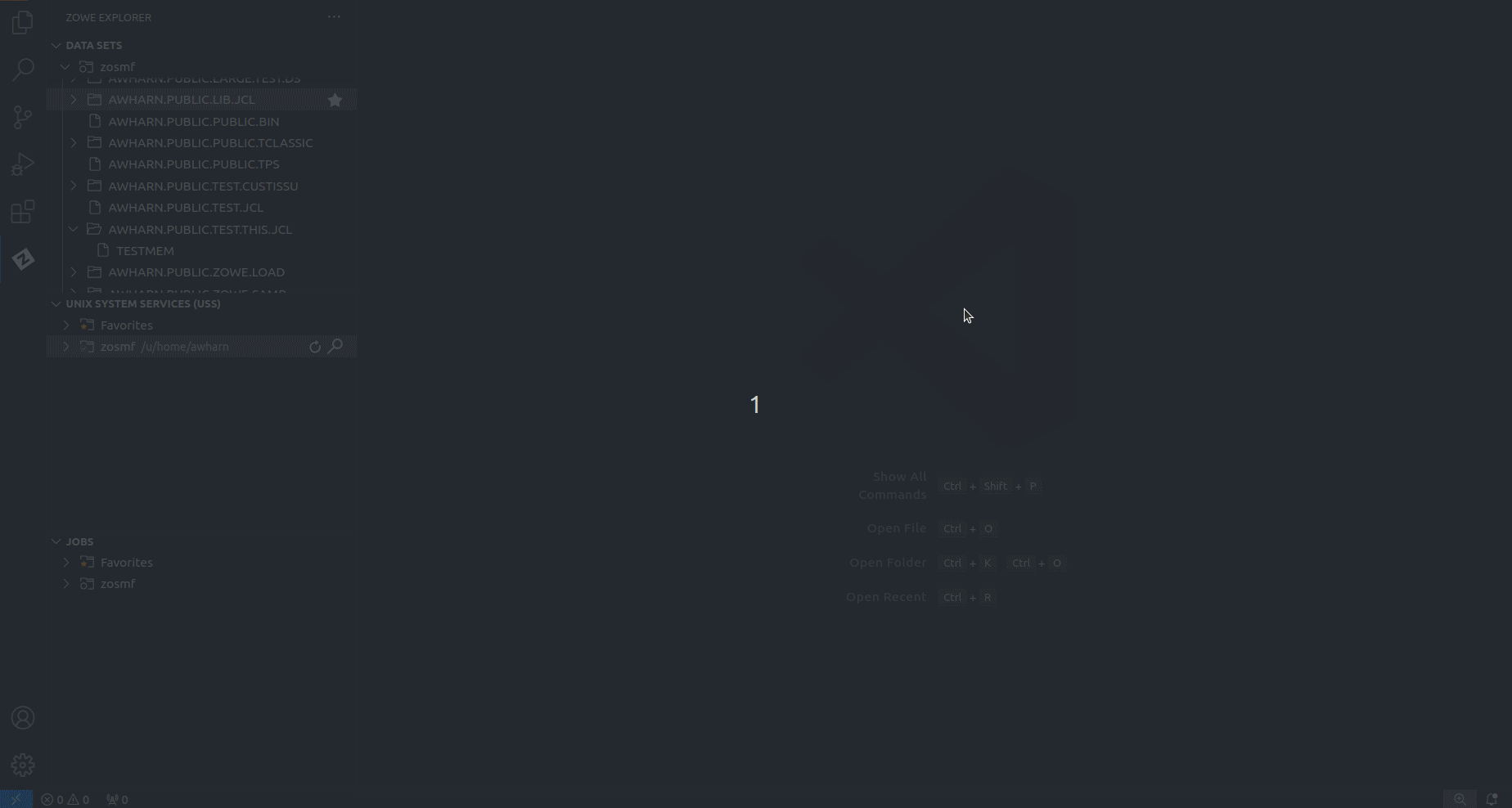
Editing and uploading a data set member
-
Expand the DATA SETS tree in the Side Bar.
-
Click on the Search icon next to a profile to search for a pattern that matches the data set that you want to view.
Search results display under the profile in the Side Bar.
-
Open the data set with the member you want to edit.
-
Click on the member name to display it in an Editor.
-
Edit the document in the Editor.
-
Press the
Ctrl+SorCommand+Skeys to save the changes.The changes are saved and the edited data set is uploaded to the mainframe.
noteIf someone else has made changes to the data set member while you were editing, you can merge your changes before uploading to the mainframe. See Preventing merge conflicts for more information.
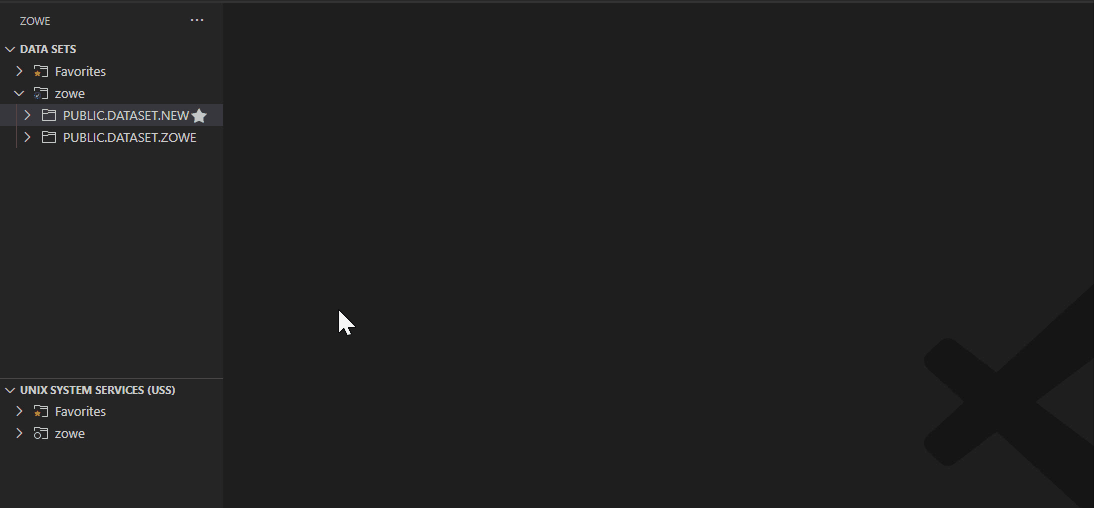
Uploading a local file to a data set
-
Expand the DATA SETS tree in the Side Bar.
-
Click on the Search icon next to a profile to search for a pattern that matches the desired data set.
Search results display under the profile in the Side Bar.
-
Right-click on the desired PDS and select the Upload Member... option to upload a local file as a member of that data set.
A file explorer window opens.
-
In the file explorer, select the desired file and click Upload File.
The selected file is uploaded as a member of the data set and appears as a new member in the DATA SETS tree after the upload is complete.
Comparing data set members
-
Expand the DATA SETS tree in the Side Bar.
-
Click on the Search icon next to a profile to search for a pattern that matches the desired data set.
Search results display under the profile in the Side Bar.
-
Right-click on the desired member and select the Select for Compare option.
-
Right-click a second member and select the Compare with Selected option.
The first selected member displays in an Editor on the left; the second member displays on the right.
Preventing merge conflicts
-
Expand the DATA SETS tree in the Side Bar.
-
Click on the Search icon next to a profile to search for a pattern that matches the desired data set.
Search results display under the profile in the Side Bar.
-
Select the member to open the file in an Editor.
-
Edit the document in the Editor.
-
Press the
Ctrl+SorCommand+Skeys to save the changes.If the original content in your local version no longer matches the same file in the mainframe, a warning message displays advising the user to compare both versions.
-
If necessary, use the editor tool bar to resolve merge conflicts.
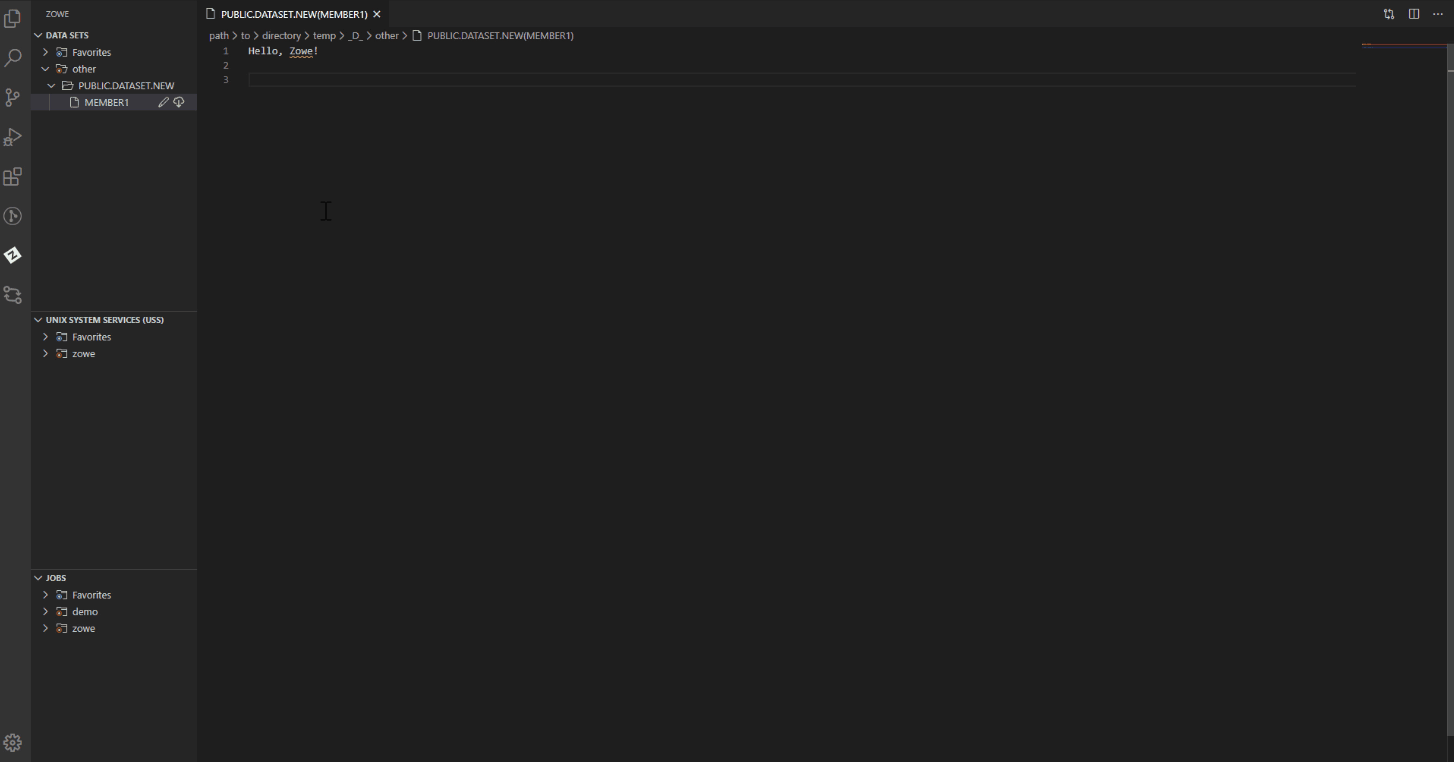
Creating data sets and specifying parameters
-
Expand the DATA SETS tree in the Side Bar.
-
Right-click on the profile you want to create a data set with and select Create New Data Set.
-
Enter a name for your data set in the input box and press the
Enterkey. -
From the Quick Pick menu, select the data set type that you want to create and press the
Enterkey. -
Select Edit Attributes in the Quick Pick menu and press the
Enterkey.The attributes list for the data set displays. You can edit the following attributes:
-
Allocation Unit
-
Average Block Length
-
Block Size
-
Data Class
-
Device Type
-
Directory Block
-
Data Set Type
-
Management Class
-
Data Set Name
-
Data Set Organization
-
Primary Space
-
Record Format
-
Record Length
-
Secondary Space
-
Size
-
Storage Class
-
Volume Serial
-
-
Select the attribute you want to edit, provide the value in the input box, and press the
Enterkey. -
(Optional) Edit the parameters of your data set.
-
Select the + Allocate Data Set option.
The data set is created and listed under the profile in the Side Bar.

Creating data sets and data set members
-
Expand the DATA SETS tree in the Side Bar.
-
In the Side Bar, right-click on a partitioned data set and select Create New Member.
-
Enter a name for your new data set member in the input box and press the
Enterkey.The member is created and opened in an Editor.
Deleting a data set member and a data set
-
Expand the DATA SETS tree in the Side Bar.
-
Open the profile and data set containing the member you want to delete.
-
Right-click the member and select Delete Member.
-
Confirm the deletion by selecting Delete on the Quick Pick menu.
-
To delete a data set, right-click the data set and select Delete Data Set, then confirm the deletion.

Viewing data set, member attributes
-
Expand the DATA SETS tree in the Side Bar.
-
Click on the Search icon next to a profile to search for a pattern that matches the data set that you want to upload to.
Search results display under the profile in the Side Bar.
-
Right-click a data set or member and select the Show Attributes option.
The attributes display in an Editor.
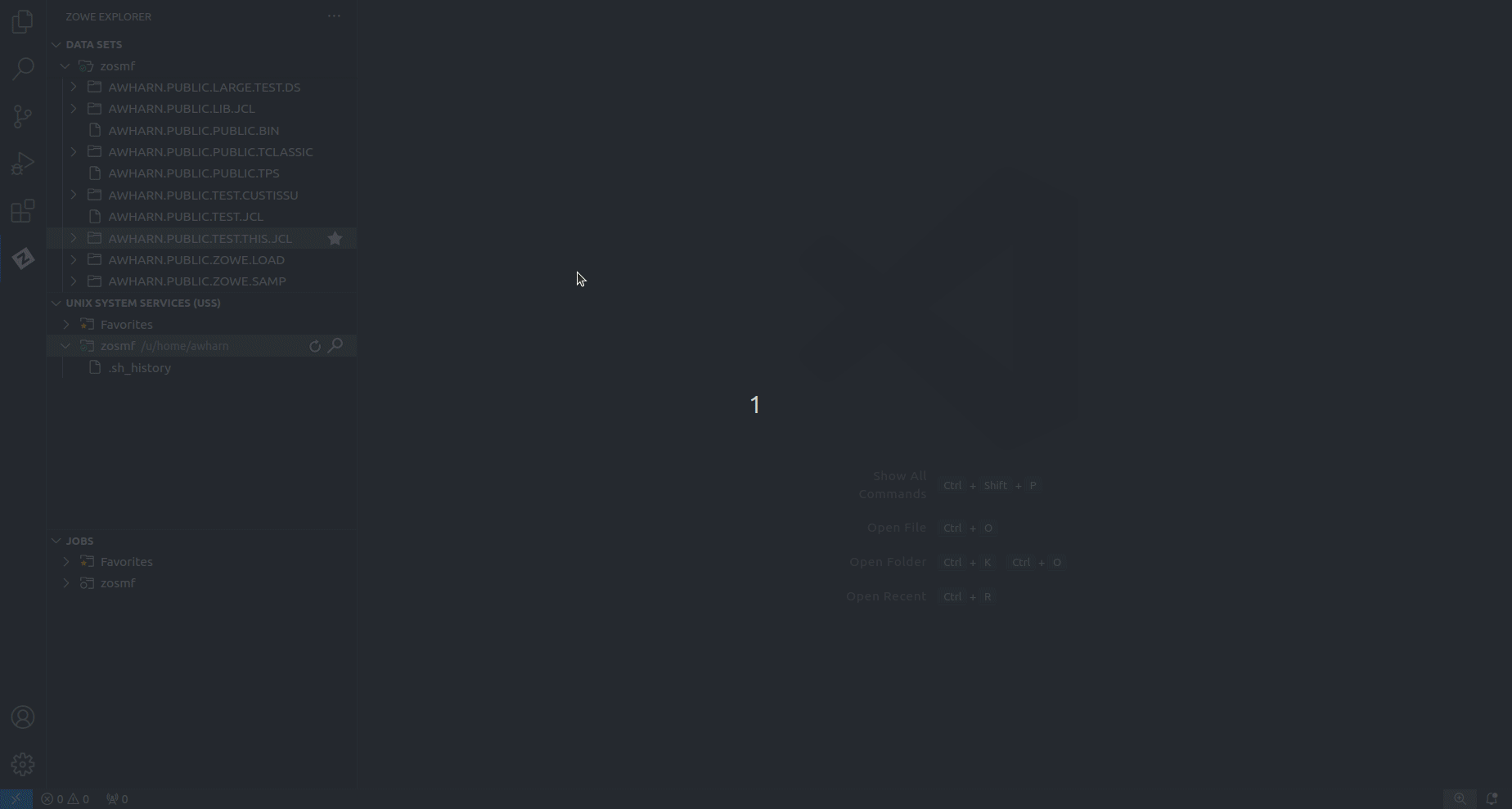
Filtering partitioned data set members
Filter partitioned data set members in the DATA SETS tree view by Date Modified or User ID.
Filtering all partitioned data set members under a specific profile
-
Expand the DATA SETS tree in the Side Bar.
-
Navigate to a profile and click on the Filter icon to the right of the profile.
The filter selection menu appears in the Quick Pick.
-
Select a filter type from the list of available options:
- Date Modified
- User ID
-
In the Quick Pick, enter a valid value for the selected filter.
-
Press the
Enterkey to confirm the filter.Expanded data sets display a filtered list of members under the selected profile in the DATA SETS tree.
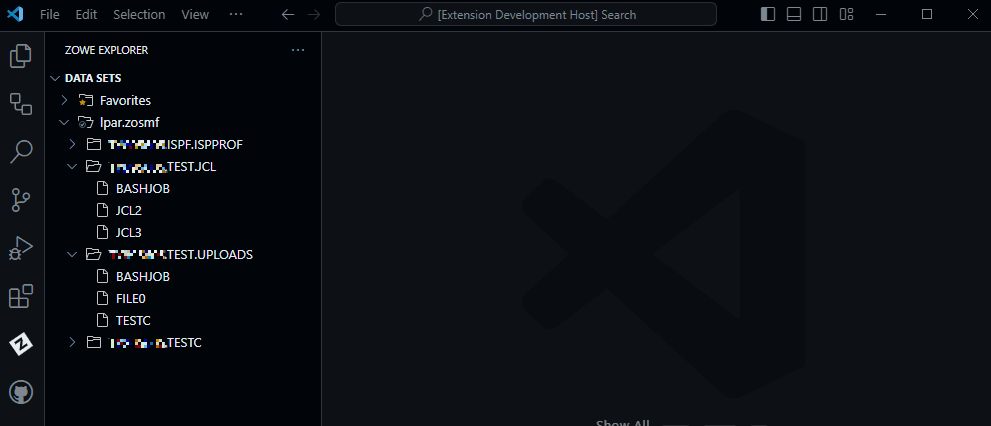
Filtering members for a single partitioned data set
-
Expand the DATA SETS tree in the Side Bar.
-
Click on the Search icon next to a profile to search for a pattern that matches the data set that you want to filter.
Search results display under the profile in the Side Bar.
-
In the DATA SETS tree, right-click on a data set and select the Filter PDS members… option.
The filter selection menu appears in the Quick Pick.
-
Select a filter type from the list of available options:
- Date Modified
- User ID
-
In the Quick Pick, enter a valid value for the selected filter.
-
Press the
Enterkey to confirm the filter. This overrides any profile filter preferences that might be in effect for the single data set.The selected data set displays a filtered list of members in the DATA SETS tree.
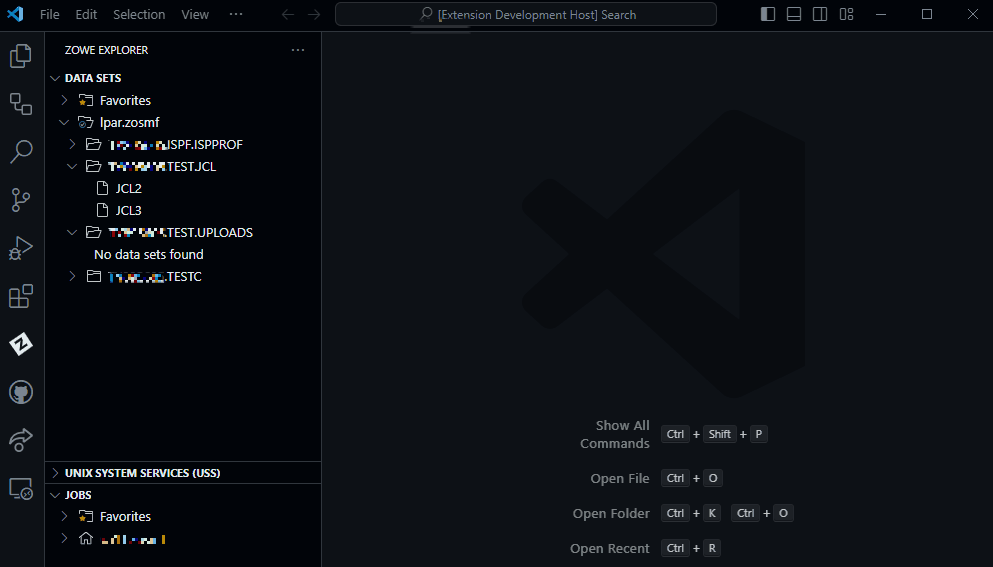
Sorting partitioned data set members
Sort partitioned data set members in the DATA SETS tree view by member Name, Date Modified, or User ID.
Sorting all partitioned data set members under a specific profile
-
Expand the DATA SETS tree in the Side Bar.
-
Click on the Sort icon to the right of a profile.
The sorting selection menu appears in the Quick Pick.
-
To change the sorting direction, select the Sort Direction option and select a direction type from the Quick Pick menu.
-
Select a sort type from the list of available options:
- Name
- Date Created
- Date Modified
- User ID
Expanded data sets display a sorted list of members under the selected profile in the DATA SETS tree.

Sorting members for a single partitioned data set
-
Expand the DATA SETS tree in the Side Bar.
-
Click on the Search icon next to a profile to search for a pattern that matches the data set that you want to sort.
Search results display under the profile in the Side Bar.
-
Right-click on a data set and select the Sort PDS members… option.
The sort selection menu appears in the Quick Pick.
-
To change the sorting direction, select the Sort Direction option and select a direction type from the Quick Pick menu.
-
Select a sort type from the list of available options:
- Name
- Date Created
- Date Modified
- User ID
This overrides any profile sort preferences that might be in effect for the single PDS. The selected data set displays a sorted list of members in the DATA SETS tree.
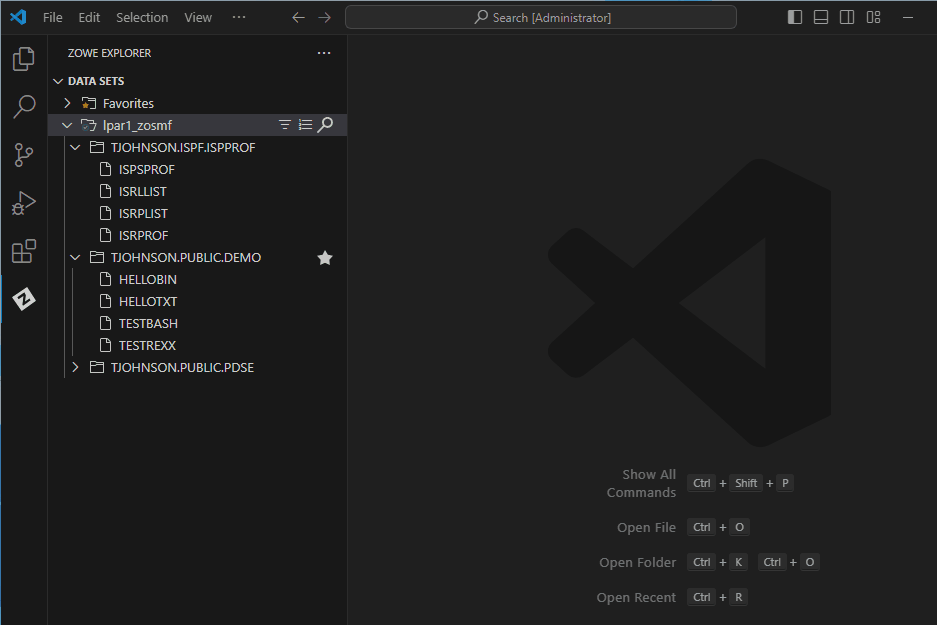
Submitting a JCL
-
Expand the DATA SETS tree in the Side Bar.
-
Click on the Search icon next to a profile to search for a pattern that matches the desired data set.
Search results display under the profile in the Side Bar.
-
Right-click the desired data set or data set member and select the Submit Job option.
The job is submitted and runs on the mainframe.
noteTo view the status of the job, click on the hyperlink on the notification pop-up message.
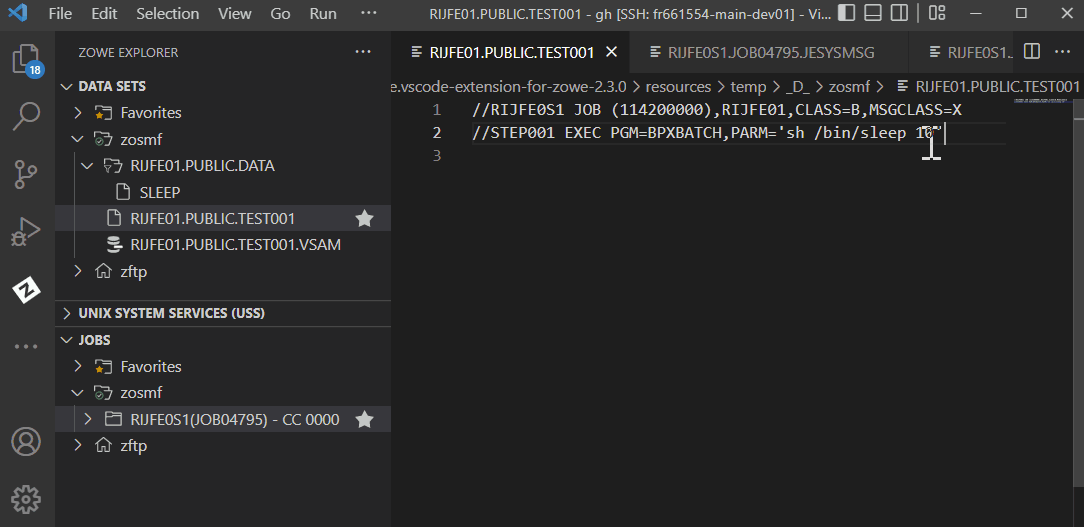
Submitting a local file as JCL
-
Go to the File menu and select the Open File... option.
-
Select the desired file on your personal computer.
The file opens as an Editor in VS Code.
-
Right-click on the file's Editor and select the option Submit as JCL.
A dialog window opens to ask confirmation, then the Quick Pick displays a list of profiles to use for the submit action. Respond to the prompt(s) as necessary.
The job is submitted and runs on the mainframe.
noteTo view the status of the job, click on the hyperlink on the notification pop-up message.
Allocate like
-
Expand the DATA SETS tree in the Side Bar.
-
Click on the Search icon next to a profile to search for a pattern that matches the desired data set.
Search results display under the profile in the Side Bar.
-
Right-click a data set and select the Allocate Like (New File with Same Attributes) option.
-
Enter the new data set name in the input box and press the
Enterkey.The new data set displays under the selected profile.
